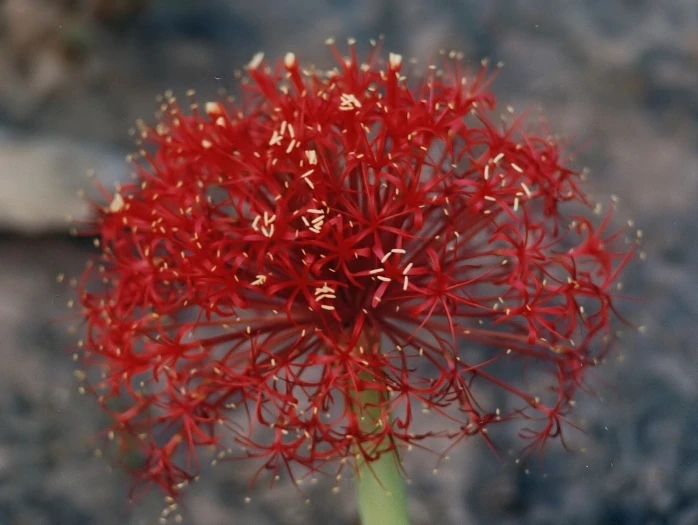Oxbane
(Boophone disticha)
Oxbane (Boophone disticha)
/
/

Hans Hillewaert
CC BY-SA 4.0
Image By:
Hans Hillewaert
Recorded By:
Copyright:
CC BY-SA 4.0
Copyright Notice:
Photo by: Hans Hillewaert | License Type: CC BY-SA 4.0 | License URL: https://creativecommons.org/licenses/by-sa/4.0 | Uploader: Lycaon | Publisher: Wikimedia Commons | Title: Boophone_disticha.jpg | Notes: ''Bouteloua curtipendula'' Source: NRCS Plant Materials Center, http://plant-materials.nrcs.usda.gov/gallery/photogallery.html {{PD-USGov}} [[Category:Poaceae]] |


























































Estimated Native Range
Climate Requirements for Machida, Japan
| This Plant | Your Site | Plant Suitability for Your Location | ||
|---|---|---|---|---|
| • Precipitation | 4" - 74" | 63" | Aquatic | Aquatic |
| • High Temp. | 71°F - 98°F | 86°F | Your summer temperatures are normal for this plant. | Excellent |
| • Low Temp. | 20°F - 67°F | 32°F | Your winter temperatures are normal for this plant | Excellent |
This plant may not grow well at your location - your precipitation is too high.
Summary
Boophone disticha, commonly known as Oxbane, is a deciduous perennial bulb native to the grasslands and rocky slopes of Southern and Central Africa. It typically grows to a height of 0.3 feet (10 cm) and a width of 0.5 feet (15 cm). This plant is notable for its striking, large, spherical flower heads consisting of numerous pink to red flowers that bloom in late winter to spring, depending on the local climate. The flowers are followed by a distinctive fan-shaped arrangement of leaves. Boophone disticha’s bulb is partially exposed above the soil, giving it a unique appearance in the landscape.
Oxbane is valued for its medicinal properties and is used in traditional African medicine, though it is highly toxic and should be handled with care. In cultivation, it is appreciated for its unusual form and showy flowers, making it a conversation piece in rock gardens, xeriscapes, and as a container specimen. It requires full sun and well-drained soil, and while it tolerates dry conditions, it benefits from regular watering during the growing season. After flowering, the plant goes dormant, and water should be reduced. It is not commonly affected by pests or diseases but can suffer from rot if overwatered.CC BY-SA 4.0
Oxbane is valued for its medicinal properties and is used in traditional African medicine, though it is highly toxic and should be handled with care. In cultivation, it is appreciated for its unusual form and showy flowers, making it a conversation piece in rock gardens, xeriscapes, and as a container specimen. It requires full sun and well-drained soil, and while it tolerates dry conditions, it benefits from regular watering during the growing season. After flowering, the plant goes dormant, and water should be reduced. It is not commonly affected by pests or diseases but can suffer from rot if overwatered.CC BY-SA 4.0
Plant Description
- Plant Type: Bulb
- Height: 1-1.5 feet
- Width: 0.333-0.5 feet
- Growth Rate: Slow
- Flower Color: Pink, Red
- Flowering Season: Winter, Spring
- Leaf Retention: Deciduous
Growth Requirements
- Sun: Full Sun
- Water: Medium
- Drainage: Fast
Common Uses
Fragrant, Low Maintenance, Showy Flowers
Natural Habitat
Grasslands and rocky slopes in Southern and Central Africa
Other Names
Common Names: Bushman Poison Bulb, Candelabra Flower, Cape Poison Bulb, Century Plant, Fan Leaved Boophone, Kaffir Onion, Poison Bulb, Red Posy, Sore Eye Flower, Veld Fan
Scientific Names: Boophone disticha, Haemanthus ciliaris, Boophone toxicaria, Haemanthus toxicarius, Amaryllis disticha, Boophone disticha var. ernesti-ruschii, Brunsvigia ciliaris, Brunsvigia rautanenii, Haemanthus sinuatus
GBIF Accepted Name: Boophone disticha (L.f.) Herb.